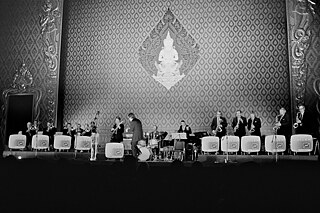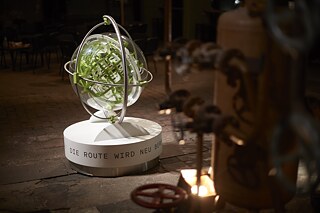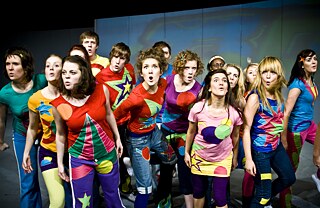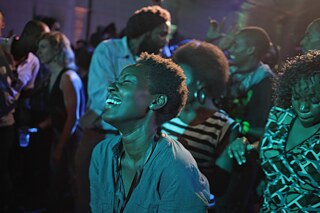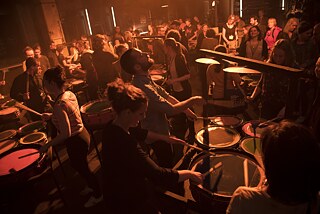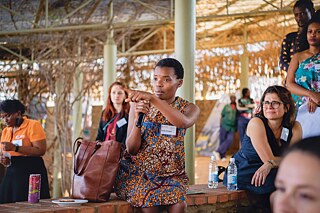The Goethe-Institut
In profile
Once an exporter of culture, today a global networker: The Goethe-Institut has frequently changed tracks over the course of its history. From ballet in traditional German folk dress in the 1960s to the discourse on postcolonialism of the present day.
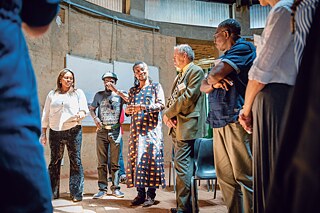
The Deutsche Akademie
The forerunner to the Goethe-Institut, the Deutsche Akademie, was founded in 1925 as the “Akademie zur wissenschaftlichen Erforschung und Pflege des Deutschtums” (Academy for the Scientific Research and Promotion of Germanness). The goal of the Munich-based private association was to research and disseminate German culture and promote the German language abroad. It was a clearly patriotic undertaking: Against the backdrop of the recently lost First World War and the resulting Treaty of Versailles, the founding fathers, all professors at Universtität München, wanted to establish “an intellectual organisation to help a free German nation regain its place in the sun through resolute and purposeful work,” as they noted at the time.The statutes of association were even more explicit: the founders’ defined the Akademie’s dual mission as “the cultivation of Germanness” and the promotion of “unofficial cultural relations with foreign countries and Germans abroad with the homeland in the service of German national consciousness and pride”. The members were mostly nationalist conservatives, though artists like Thomas Mann and Max Liebermann, and Cologne’s mayor and the president of the Prussian State Council, Konrad Adenauer, were also involved.
After the National Socialists seized power, the Akademie underwent what could retrospectively called “Selbstgleichschaltung” or voluntary coordination: The people in charge toed the line with the new regime, adapting ideologically with little to no protest or criticism. Jews like Liebermann were forced out of the organisation, as was centrist politician Adenauer. Nazi Party members and people with close ties to the regime replaced them at the Deutsche Akademie where SA-Standartenführer Leopold Kölbl was the first Nazi appointed president of the organisation in 1938.
In 1941, the Akademie was changed to a public corporation by decree and from then on directly served the dictatorial regime. The Nazi regime used the Akademie’s structures to further its own ends, investing in its work and in the expansion of its foreign network. During denazification, the Deutsche Akademie was classified as a former National Socialist organisation and dissolved in 1945.
This kind of a past requires an honest reappraisal and engagement with all the activities that took place from 1933 to 1945, including all the ideas that were furthered, and not least with the people responsible for organising and driving these activities forward. No such reappraisal takes place in the early years after the fall of the Nazis or for many years afterwards. It goes even further: Some former high-ranking Nazi functionaries find employment at the Goethe-Institut, such as the former SS-Obersturmführer in the Reich Security Main Office, Hans Egon Holthusen, who is entrusted with the management of the Goethe-Institut New York in 1961.
When the rebuilding of the Goethe-Institut begins in 1951, the founders at least reflect on the circumstances that made the Akademie so vulnerable to political and ideological appropriation. They therefore choose to set the Goethe-Institut up as a registered association. This is intended to protect the Institut from ever being instrumentalised by the state again. And conversely, the Federal Republic also learns a lesson from the Nazi era and begins organising foreign cultural policy in a decentralised way, putting it in the hands of non-state actors, so-called intermediary organisations.
“Goethe” stays
Incidentally, the “Goethe-Institut” name was not new either: The Deutsche Akademie had a department of the same name. It was responsible for practical matters, trained foreign German teachers, and taught German abroad. Changing the name and making it the title of the entire organisation was a well-considered decision: It signalled that the new organisation would continue the work of the Deutsche Akademie – though before it was taken over by the Nazis, mind. Additionally, it was hoped taking the same name would provide a legal claim to the Akademie’s legacy as a financial jump start.
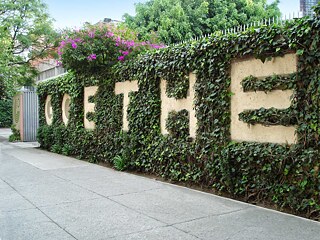
From language work to cultural mediation
It is the 1960s, and the Institut’s mission is visibly changing: The focus on bringing people from other countries to Germany to learn to teach the language now officially expands to include cultural work abroad. This is a two-way street from the very start. Although the Goethe-Institut sends German musicians, authors, and artists out into the world in the first few years, this cultural export often results in mutual exchange – such as when The German All Stars jazz band jams with local musicians and even Thailand’s King Bhumibol Adulyadej during their tour of Asia. “He played very nicely for a king,” trombonist Albert Mangelsdorff later says about the king’s saxophone chops.Alpenglühen on tour
Welcome to the era of Alpine romanticism: Following Peter Alexander’s cinematic and musical triumph with “Im Weißen Rössl” (The White Horse Inn) a year earlier, and only four years before the U.S. “Sound of Music” and its Alpine music soundtrack premieres in cinemas, a ballet troupe decked out in traditional Bavarian folk dress, the Trachtenballet, dances through India against a set with a rich alpenglow in 1961. Organiser: the Goethe-Institut. The special German Foreign Office envoy for German cultural institutes abroad, who brought the idea back from a trip to India, hopes for “stimulating interactions” between the South Asian country and Germany and its dance culture.But the traditional folk costume trend is soon played out. Dirndls, yodelling and Schuhplattler folk dancers fall out of fashion, and anyone who invokes the Alpine topos to convey an image of Germany abroad is even accused of bad taste. An Institut insider is one of the first critics: Eckart Peterich, briefly program director of the Goethe-Institut, must have squirmed in his seat when he attended a rehearsal of the Trachtenballet dance troupe before the tour.
A contemporary later recalls how the writer “sighed deeply several times” in displeasure during the performance. Previously head of the German libraries in Milan and Rome, Peterich has poetry readings, exhibitions, and modern theatre in mind as worthy contenders for cultural mediation. But whirling, twirling dirndls? Offering an unobstructed view of the dancers’ undergarments? That, he feels, is simply an expression of poor taste. And so he takes the logical next step: While the Bavarian ballet company celebrates a successful tour through India against its artificial Alpine backdrop, Eckart Peterich submits his resignation in Munich in 1963.
The Goethe-Institut defies political pushback
Almost another decade will pass before a different understanding of culture prevails. The creators of cultural programs finally turn to contemporary and critical art by the early 1970s, when literary works by Günter Grass and Heinrich Böll get their due, as does contemporary visual art from artists like Klaus Staeck. This directional shift is supported by the “Guiding Principles for Foreign Cultural Policy” paper Ralf Dahrendorf drafts for the Federal Foreign Office. In it, the parliamentary state secretary and sociologist calls for a focus on “contemporary cultural and civilising problems” and urges more attention directed at mutual exchange with partners in the host country rather than self-promotion. Some Goethe-Institut staff members were already taking this approach as early as the 1960s. The institute now sees itself as a pioneer for this new foreign cultural policy trajectory.The critical stance the Institut continues to take is reflected in various political controversies triggered by some of the institute’s activities or funding choices. In 1964, Der Spiegel news magazine publisher Rudolf Augstein gives a lecture at the Goethe-Institut Paris entitled “Classical Misunderstandings between the Post-war Democracies in France and Germany”. The German Foreign Office issues a stern reprimand to the Institut in response. That same year, the Goethe-Institut is at the centre of a Bundestag debate because it gives writer Golo Mann a stage in Rome to talk about the prickly issue of the border between Germany and Poland. Outraged members of the Bundestag threaten to withdraw funding from the Institut.
Ten years later, then Foreign Minister Hans-Dietrich Genscher publicly admonishes the Institut for co-sponsoring a Klaus Staeck exhibition in which the artist satirizes German politicians. A year later, in 1975, the German Bundestag censures the Goethe-Institut for organising an evening event in Rome that takes its title from the Erich Kästner poem: “Kennst du das Land, wo die Kanonen blüh’n” (Do you know the land where the cannons bloom). Kästner’s poem is an antimilitary parody of Johann Wolfgang von Goethe’s poem “Mignon (Kennst du das Land, wo die Zitronen blühn?)” (Do you know the land where the citrons bloom).
“In bright and festive hues, please!”
Franz Josef Strauß was one of the most prominent critics of the Institut’s work. The CSU politician and long-time Bavarian minister president frequently condemns events held at the behest of or instigated by the Goethe-Institut. He is particularly harsh in a programmatic speech at a general meeting in 1986, where he demands the Goethe-Institut highlight the country’s good sides instead of using what he called a “gloomy, Twilight of the Gods palette”. He had a specific role model in mind too: He wanted the Federal Republic of Germany depicted abroad in “bright and festive hues” like the German Democratic Republic. Then Foreign Minister Genscher disagreed. And the Goethe-Institut maintained its course.
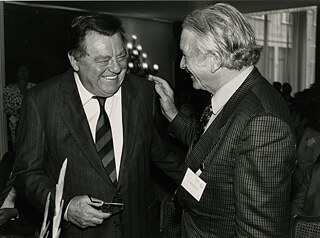
The Goethe-Institut as global networker
The world has changed since two hijacked passenger planes brought down the World Trade Center towers in New York. While cultural work has always aspired to encourage exchange across political, geographical, and cultural borders, this aspect is now more crucial than ever. Foreign cultural policymakers want to focus even more intently on international understanding, communicating values, and issues around democracy building and securing human rights.The events of September 11, 2001 were not the trigger though; they were the accelerator of a new course already being mapped out in Germany in 1999. In “Konzeption 2000”, the German Foreign Office’s Department of Cultural Affairs drafted guidelines for future cultural work abroad, pointing out, for example, how quickly international relations and the interdependence of countries changed in the era of globalization, driven in part by the new digital communication and information channels. The Federal Foreign Office recognises the world as a “global village” and wants to play its part “through a critical discussion of values and an active role in knowledge management as well as cultural and information policy dialogue”, as it notes in the strategic document.
In practical terms, the Goethe-Institut’s recalibration is manifests in an increased use of new media, the launching of a website, and the promotion of a worldwide “information, learning and knowledge society”. Many programs and events now broach the issue of conflict prevention and centre around dialogue with the Islamic world and advocating for democratic values.
The more intense networking taking place in the “global village” is also reflected in a reorientation of the Goethe-Institut’s programmes. After a primary focus on showcasing German culture abroad in the first two decades followed by binational and partnership-based collaboration in the 1970s, since the turn of the millennium and the 2010s in particular, the Goethe-Institut has focused on multinational and multi-perspective approaches and is well on the way to becoming a global networker.
Such as in 2008, when the Goethe-Institut calls on European playwrights to explore the social changes in their respective countries after the fall of the Berlin Wall. The “After the Fall” project produced 16 plays performed in 15 European countries. This kind of cross-border initiative addressing disintegration and liberation, taboos and nationalism, exclusion and unity from many European perspectives, requires a working knowledge of the countries involved and a network with the local cultural scenes – attributes that characterise the Goethe-Institut.
The “Latitude” online magazine invites global exchange about colonial power relations, their consequences and overcoming them, and at the digital festival of the same name in 2020, intellectuals and artists from Africa, Latin America, Asia and Europe discuss racism, identity and the culture of remembrance. Especially against the background of the Goethe-Institut’s predecessor and early history, visualising other perspectives and a self-critical stance of attentive listening is essential for the Institut to continue its positive global cultural work focused on values and current issues.
Translation: Sarah Smithson-Compton
